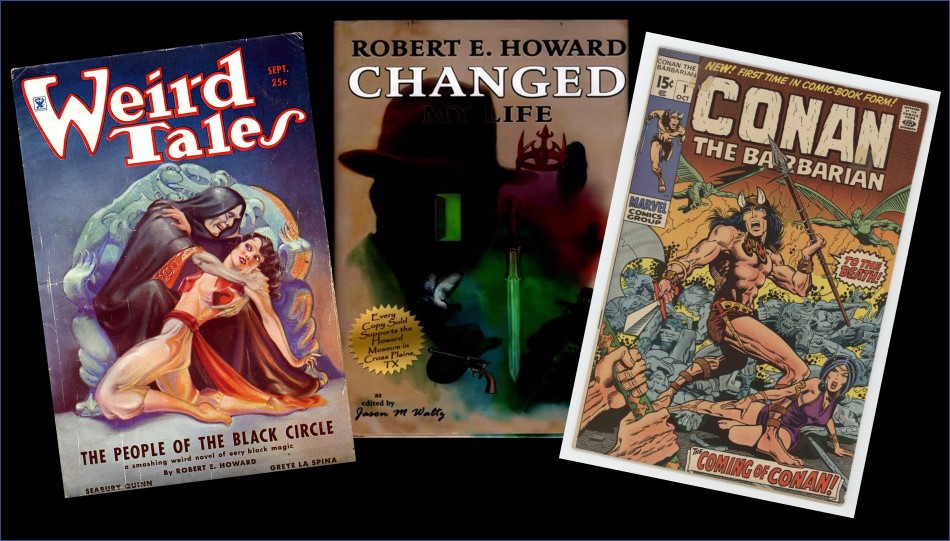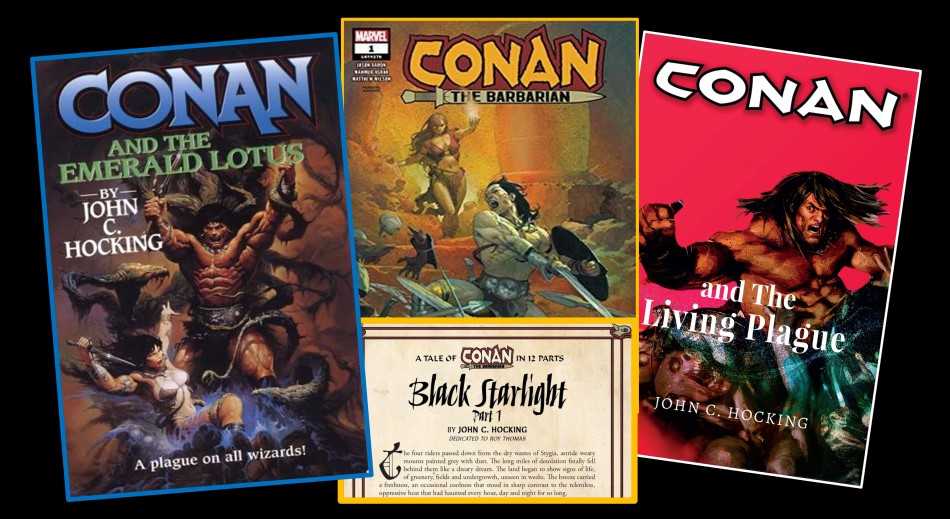Beautiful Plagues: An Interview with John C. Hocking
 To help reveal the muses that inspire weird fiction and horror writers, this interview series engages contemporary authors on the theme of “Art & Beauty in Weird/Fantasy Fiction.” Recent guests on Black Gate broaching this topic have included Darrell Schweitzer, Sebastian Jones, Charles Gramlich, Anna Smith Spark, & Carol Berg, Stephen Leigh, Jason Ray Carney. See the full list of interviews at the end of this post.
To help reveal the muses that inspire weird fiction and horror writers, this interview series engages contemporary authors on the theme of “Art & Beauty in Weird/Fantasy Fiction.” Recent guests on Black Gate broaching this topic have included Darrell Schweitzer, Sebastian Jones, Charles Gramlich, Anna Smith Spark, & Carol Berg, Stephen Leigh, Jason Ray Carney. See the full list of interviews at the end of this post.
Today we corner John C. Hocking whose Conan pastiche we reviewed a few months ago.
John C. Hocking is an American fantasy writer who is the author of two well-acclaimed Conan novels and has also won the 2009 Harper’s Pen Award for Sword and Sorcery fiction for his story, “The Face In The Sea”. He lives in Michigan with his wife, son, and an alarming quantity of books. He is a nigh-obsessed reader and writer of lurid pulp fiction, the author of Conan and the Emerald Lotus, the “Black Starlight” Conan serial, and their time-lost companion, Conan and the Living Plague, and an obedient thrall of Tales From the Magician’s Skull.
For clarity, we’ll actually corner him twice. Firstly, here on Black Gate, we’ll cover his weird, pulpy muses & Conan pastiche; secondly, in a companion interview, we’ll cover his King’s Blade and Archivist series on the Tale from the Magician’s Skull Blog.
CONAN PASTICHE
In Rogue Blades Foundation’s Robert E. Howard Changed My Life, you contributed the essay “REH, Conan and Me” (readers should get that book to learn details). Can you comment more on how the supernatural horror of “The People of the Back Circle” (your first REH exposure) affected you?
[JCH] I was a kid when I read it and that story provided my first encounter with a lot of things. The supernatural horror of the Seers of Yimsha shook me because it was so visceral, so physical and so twisted. The tale starts with the wizards of the title reaching out to seize the King of Vendhya’s soul and it’s so horrific that he begs his own sister to stab him to death just to get away from them. The supernatural, in this swashbuckling fantasy adventure, is as frightening as anything in a well-wrought horror story. That stuck with me.
Let’s pretend you get to contribute to a Howards Phillips Lovecraft or Clark Ashton Smith “Changed My Life” anthology. What inspirations have you had for cosmic horror or weird fiction?
[JCH] I’m a Weird Tales fan to the marrow and admire the achievements of both HPL and CAS. Lovecraft’s conception of what made a story of supernatural horror resonate with the reader, and his attempts to create work that met his own standards, revealed a profound understanding of, and dedication to, weird fiction as a high craft. This was powerfully inspiring, even if it did make much of the horror I’d read seem shallow and undistinguished. I try to burnish any supernatural element in my own writing with elements of ‘cosmic horror’ or what HPL called spectral fear. I’ve never been able to do more than touch on it, but I hope to write at least one memorable horror story that’s true to HPL’s tenets before I’m done.
Comics were influential in your youth and creative development. Can you comment on how reading comics informed your writing? How cool is it to have your “Black Starlight” serialized novella appear in 12 issues of Marvel Comic’s Conan the Barbarian?
[JCH] I was surprised that they wanted to include prose fiction in the comic and delighted that they used my work. That said, the serial format keeps the full story out of the hands of all except those who picked up each of the first twelve issues of the magazine, so I hope we see ‘Black Starlight’ collected in a book right beside the other serial fiction Marvel commissioned.
I read the Marvel Conan comics written by Roy Thomas every month from when I was 12 until I was 20 and he left the magazine. The consistent presence of the Conan character across some of my most tumultuous and formative years was both a comfort and an encouragement. The comic showed me that Conan pastiche could take a different form, play by different rules and still do honor to REH’s character. And it showed me that good pastiche could still be produced, that stories written about Conan could keep coming and that maybe even I could try to write one.
In the recent Black Gate review of Emerald Lotus & “Black Starlight” I highlighted one of my favorite battle scene: Conan and crew vs. the demonic, mega-flora oasis creature. If you were to highlight a scene, which one would it be?
[JCH] There are several sequences in Emerald Lotus in which I tried to conjure up some of that old school Weird Tales atmosphere—the scene in which the sorcerer Ethram-Fal finds that one of his men has been surreptitiously sacrificed to Nyarlathotep, for instance. But the scene I put the most effort into is Conan and Heng Shih’s battle with Ethram-Fal’s mercenaries over the lotus pit. I was all but obsessed with trying to write the kind of battle that Stopped The Show. A full-on, balls-out, hack-n-slay display of exhausting combat against the odds that could stand in the shadow of the best Sword & Sorcery battle scenes I’d read. I rewrote that scene entirely 14 times simply trying to hold a candle to the hellfire to be found in Solomon Kane’s clash with the Akaana in ‘Wings in the Night’, with Kull’s battle on the stairs in ‘Swords of the Purple Kingdom’ or Conan’s donnybrook with Thog in ‘Xuthal of the Dusk’. While I still find my scene to be pretty good, nobody has said a word about it to date. If you read the book, please take note of the scene and see if I get points for trying.
You’ve endured and enjoyed publishing experiences with the Conan IP. You broke into writing Lotus in 1995, and even though “Black Starlight” made it to print in 2019, the pseudo-follow-up novel to Emerald Lotus called Living Plague was pulled at the last minute. Not to pick scabs, but readers may be hopeful for any update or perspective. Can you comment on any part of your journey? Any pastiche for the future?
[JCH] While I’m pleased to have made some contribution to the Cimmerian’s saga, writing pastiche has been a rocky road. Lotus has been out of print for more than twenty years, and Living Plague came within inches of being published twice and died on the doorstep each time. Lately I’ve heard some appreciative things about Lotus, which is heartening even all these years later, but the book got its share of negative feedback. A pastiche that appeared before REH’s restored works were available, it won me some choice bits of hate mail when it first appeared.
When it seemed that Conan and the Living Plague was finally going to be published, I got pretty fired up, and outlined a new Conan story set in Asgard and Vanaheim. And I was approached with the suggestion that I go back to work on the Conan pastiche I’d begun way back when Living Plague was completed. I found notes and a partial manuscript for Conan in the City of Pain but put them aside when plans to print Lotus and Living Plague fell through. While I’d be game to write more about the Cimmerian I can’t afford to give it much thought until my second pastiche finally sees publication.
Sidebar: the Perilous Worlds imprint handling publications stumbled…which happens often, unfortunately. Note that all Conan IP was just purchased by Funcom in late 2021, so the ownership is ever-changing and complicated (fiction falls under its Heroic Signatures entity).
I appreciate you sharing the manuscript of the almost published Living Plague. It reads like a S&S-bank-heist novel. Conan and a gang break into a quarantined, plague city to recover treasure; catacombs, ghouls, and zombies, and tons of necromancy. Some of the initial settings from Emerald Lotus begged to be addressed again (i.e., the fate of Conan’s mercenary buddy Shamtare and King Sumuabi’s need for raising armies) and you developed them further in Plague. Let’s discuss some teasers without spoiling anything:
Both Emerald Lotus and the Living Plague-manuscript have prologues that focus on an apprentice/sorcerer relation that is dysfunctional. Brilliant way to set up the conflict. Can you comment on plot design and organizing novels, and perhaps your perspective on sorcerers?
[JCH] Howard’s The Hour of the Dragon begins with a chapter showing the resurrection of the story’s villain, Xaltotun. I like the idea of teasing readers with a look at the potential challenges and adversaries the Cimmerian will be forced to overcome. And starting my books in emulation of the only canonical Conan novel just felt right.
I outline extensively and did my best to keep a driving pace with chapters ending on a sharp note or revelation. In this sense, my Conan books owe something to the Gold Medal Original novels of the 1950’s. I admire their fierce pace and narrative drive—something that’s become uncommon in modern fiction and quite rare in fantasy.
I wanted my sorcerer villains to be the sort of people who were tempted to latch onto personal power, power they convinced themselves they deserved, and to do so despite its obvious dark, undependable and dehumanizing nature. These guys are evil through self-indulgence, self-deception and moral weakness. Also, having seen perhaps a few too many fictional wizards who could perform spectacular miracles with the wave of a hand, I opted to make my sorcerers more limited and uncertain in their skills.
The living-plague is airborne; COVID-conscious readers would latch onto the protective masks now.
[JCH] Yeesh. I can now see that aspect of the book as being called out as trendy or, worse, politically relevant. Ugh. Please keep in mind I wrote Living Plague in 1996.
S&S tends to have one hero (maybe a duo). In your Conan pastiche, almost everyone has a partner or bodyguard (friend or foil). When designing heroic fiction, what do you consider for heroes (solo or teamed)?
[JCH] This is different for hero and villain. The villain needs bodyguards/followers to do his will and to provide additional colorful and dangerous threats for the hero to overcome. I found that, at times, putting Conan, an iconic character of mythic stature, into the company of comrades to be a way of letting the reader see how the Cimmerian appears to others (that is to say, epic) without leaning too hard on the third-person narration to simply tell the reader about him.
WEIRD MUSES
How do you define Beauty in art/fiction that appears to be repulsive (weird/ horror)?
[JCH] I think Beauty in weird and horror fiction often parallels beauty in nature. There is a terrible beauty, a symmetry and elegance, in a spider’s web, in a tiger’s smile and in the technique of a parasitoid wasp. It falls to the artist to call it out, but there can be beauty in the weird and in horror even when they are at their most terrible.
Do you find beauty in your heroic fiction? Dissect an example.
[JCH] Tough and personal question, Seth. Yes, I do. I try to convey beauty in descriptive sequences, of course, and can lean into it when trying to get across something supernatural. The extradimensional demon Benhus encounters in ‘Guardian of the Broken Gem’ (Tales from the Magician’s Skull #4) is a good example. I tried to make it otherworldly and frighteningly alien but described it in terms that might be seen as beautiful.
But in my heroic fiction (and I certainly cannot speak for the reader here) I find the most beauty in the connections I’m trying to forge between characters. I make sure my characters are up against serious adversity as much as I can and try to show, directly and indirectly, how this bonds them together. In ‘The Bonestealer’s Mirror’ (Black Gate #14) Brand, the narrator, is formidable and brave but young and unsure of himself. He has come to look up to Halfdan, an older warrior in his company. Near the climax of the story Brand is trapped in the base of a small tower by a terrible, unnatural foe. His comrades can hear and partially see the conflict but cannot aid him as he battles for his life. In the claws of a demon, with his leader laid low beside him, Brand hears “Halfdan calling my name in a voice like my father’s”. At this character’s moment near extremis, I found beauty in making explicit what had only been implied in the story, and unclear in Brand’s own mind, until then.
What scares you? Is it beautiful?
[JCH] I am frightened by the immensity of history, the cosmos, and the endless catalog of all the things I can never know or understand. The incomprehensively vast expanse of the unknown scares me, but it is coldly, distantly beautiful.
But what I’m truly scared of is the loss of my family, and that is not beautiful at all.
“The most merciful thing in the world, I think, is the inability of the human mind to correlate all its contents. We live on a placid island of ignorance in the midst of black seas of infinity, and it was not meant that we should voyage far.” HPL The Call of Cthulhu (1928)
Art vs. the Artist? Is there a character that you most empathize with, or reflects you?
[JCH] Honestly, no. While most any character I’ve written has some elements of my past or present personality in the mix- the Archivist’s pedantry or Brand’s youthful confusion, for example. I don’t think I’ve ever written or even read about a character who reflected my personality with any real accuracy.
Do you practice other arts? If so, can we share them (i.e., images of fine or graphic art) or mp3s/videos (of music). Likewise, can you discuss how art from one medium can inform/inspire another?
[JCH] Alas, I can’t draw or make music worth a damn. I love music and listen to it during most of my waking hours. I get a huge emotional satisfaction from music and generally have it playing as I read or write.
MORE HOCKING
Check out the companion interview on The Tales of the Magician’s Skull Blog to learn more about Hocking’s other Sword & Sorcery characters.
Interview List Regarding #Weird Beauty on Black Gate
- Darrel Schweitzer THE BEAUTY IN HORROR AND SADNESS: AN INTERVIEW WITH DARRELL SCHWEITZER 2018
- Sebastian Jones THE BEAUTY IN LIFE AND DEATH: AN INTERVIEW WITH SEBASTIAN JONES 2018
- Charles Gramlich THE BEAUTIFUL AND THE REPELLENT: AN INTERVIEW WITH CHARLES A. GRAMLICH 2019
- Anna Smith Spark DISGUST AND DESIRE: AN INTERVIEW WITH ANNA SMITH SPARK 2019
- Carol Berg ACCESSIBLE DARK FANTASY: AN INTERVIEW WITH CAROL BERG 2019
- Byron Leavitt GOD, DARKNESS, & WONDER: AN INTERVIEW WITH BYRON LEAVITT 2021
- Philip Emery THE AESTHETICS OF SWORD & SORCERY: AN INTERVIEW WITH PHILIP EMERY 2021
- C. Dean Andersson DEAN ANDERSSON TRIBUTE INTERVIEW AND TOUR GUIDE OF HEL: BLOODSONG AND FREEDOM! (2021 repost of 2014)
- Jason Ray Carney SUBLIME, CRUEL BEAUTY: AN INTERVIEW WITH JASON RAY CARNEY (2021)
- Stephen Leigh IMMORTAL MUSE BY STEPHEN LEIGH: REVIEW, INTERVIEW, AND PRELUDE TO A SECRET CHAPTER (2021)
- interviews prior 2018 (i.e., with John R. Fultz, Janet E. Morris, Richard Lee Byers, Aliya Whitely …and many more) are on S.E. Lindberg’s website
S.E. Lindberg is a Managing Editor at Black Gate, regularly reviewing books and interviewing authors on the topic of “Beauty & Art in Weird-Fantasy Fiction.” He is also the lead moderator of the Goodreads Sword & Sorcery Group and an intern for Tales from the Magician’s Skull magazine. As for crafting stories, he has contributed five entries across Perseid Press’s Heroes in Hell and Heroika series and has an entry in Weirdbook Annual #3: Zombies. He independently publishes novels under the banner Dyscrasia Fiction; short stories of Dyscrasia Fiction have appeared in Whetstone and Swords & Sorcery online magazines.


great stuff
really wanted that imprint to make it.
Aye. Sad to see Perilous Worlds falter. Wish there was more hope for the future.
Yay!!!! Seth, that was awesome! !
It follows nicely with your recent Roy Thomas/Conan post too! Hocking was/is a big fan. https://www.blackgate.com/2022/01/31/by-crom-roy-thomas-conan-the-barbarian/
Thank you both for the intelligent and helpful questions and answers.
Appreciate that. Took several months behind the scenes to pull all that together. I’m grateful to Hocking who opened up and shared so much.
Very interesting interview. I have read and enjoyed Conan and The Emerald Lotus a great deal. Being familiar with the book, insights in the interview are nice to hear. I believe Conan and The Emerald Lotus deserves a re-print, Black Starlight and Living Plague deserve their own prints as book format.
There is always some hope…however slim.
2023 Titan books promises to publish Hocking’s pastiche! Preorder now … here is a link https://www.amazon.com/gp/aw/d/1803366567/